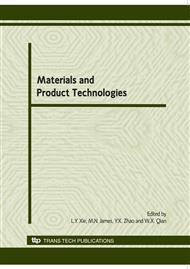p.414
p.419
p.424
p.429
p.434
p.439
p.444
p.449
p.454
Residual Stress Analysis in Curing Process of COG Module
Abstract:
In this study, the bonding reliability of the COG devices was studied. A finite element analyses model was established to study the curing process of COG module. The equivalent stress of the different locations of the package structure and the change of the temperature distribution with time were studied. The heat transfer process and the conductive particle deformation process were displayed through the simulation. The results show that the curing process is the heat transformation and particle deformation process. The residual stress generated by the temperature difference between the curing temperature and the operated temperature. The results show that the maximum residual stress is in the most distorted places of the conductive particles. The maximum residual thermal stress was studied with different bump pitch (35μm 30μm 25μm and 20μm) and the size of the particles (5μm, 4μm and 3.5μm). It shows that for a certain size of the particles, the maximum residual thermal stress will decrease when the bump pitch decreases. For a certain bump pitch, the maximum residual thermal stress will decrease when the size of the particles decrease.
Info:
Periodical:
Pages:
434-438
Citation:
Online since:
June 2010
Authors:
Price:
Сopyright:
© 2010 Trans Tech Publications Ltd. All Rights Reserved
Share:
Citation:


